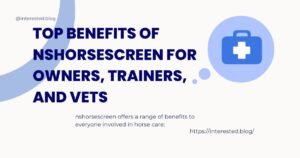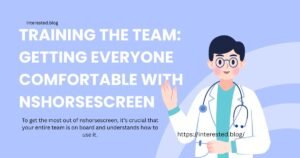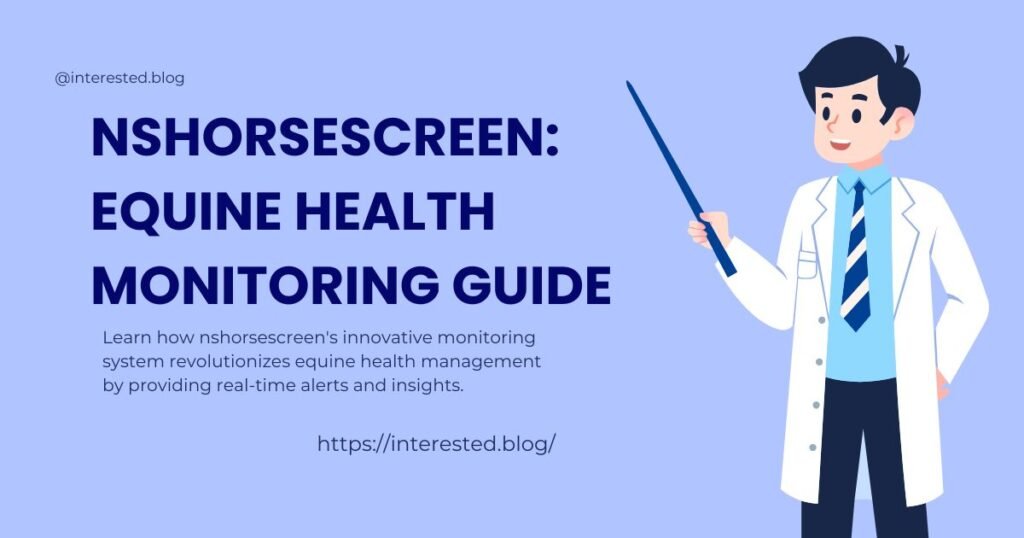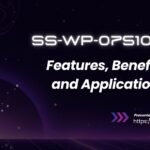Introduction
Imagine a scenario where a horse at a busy stable starts showing signs of distress. It’s early morning, the trainer is getting ready for the day’s session, and the grooms are preparing the horses. Then, a notification pops up on the mobile app: one of the horses has an abnormal spike in heart rate, a potential sign of colic. Thanks to this early alert from nshorsescreen, the stable is able to act quickly. A vet is called immediately, and a potentially serious situation is avoided before it spirals out of control. The horse receives the necessary treatment and is back on its feet in no time. This could have easily turned into a colic scare, but thanks to nshorsescreen’s innovative monitoring system, the team has the information they need to make proactive decisions.
This guide is designed to help horse owners, trainers, and vets understand how nshorsescreen can revolutionize the way they monitor horse health. Whether you’re looking to improve performance, prevent emergencies, or track progress after an injury, nshorsescreen offers a comprehensive solution for modern equine health management.
What Is nshorsescreen? A Plain-English Definition
In simple terms, nshorsescreen is a cutting-edge system that continuously monitors the health and performance of horses through a combination of wearable sensors, mobile app tracking, and cloud-based analytics. The system captures real-time data about various vital metrics such as heart rate, respiration, stride symmetry, and more. This data is then analyzed to provide actionable insights that can improve both the performance and well-being of the horse.
Unlike generic fitness trackers or wearables, which may provide basic data, nshorsescreen is specifically designed to cater to the needs of the equine world. It collects and processes complex, high-resolution data in real-time, offering owners, trainers, and veterinarians an unprecedented level of insight into the health of each horse in their care.
The Core Idea Behind nshorsescreen and How It Differs from Generic Wearables
While many wearables on the market are designed to monitor human health, nshorsescreen is specifically engineered for horses. It takes into account the unique anatomical and physiological differences between horses and humans, ensuring that the sensors and data analytics are finely tuned to equine needs. This allows for more accurate tracking of performance and health markers, enabling better-informed decisions.
In addition, while most generic wearables are simply designed for individual use, nshorsescreen is part of an integrated ecosystem that includes not just the wearable but also a mobile app and cloud-based analytics. This ecosystem allows users to track multiple horses, set up alerts, and get detailed reports—all from a single interface.
The Ecosystem: Sensors, Mobile App, Cloud Analytics
At the heart of nshorsescreen is its ecosystem of interconnected components. Here’s how it works:
- Sensors: Wearable sensors placed on the horse (typically on the girth, halter, or leg wraps) capture vital metrics such as heart rate, respiration, and movement patterns.
- Mobile App: The data from the sensors is transmitted in real-time to a mobile app, allowing users to monitor their horse’s health at any time.
- Cloud Analytics: The app is connected to cloud-based analytics, which processes the data and alerts users to any abnormalities or patterns that might suggest potential health concerns.
This ecosystem allows for continuous, real-time monitoring of your horse’s health, making it easier to detect issues early before they escalate into bigger problems.
How nshorsescreen Works Under the Hood
The process behind nshorsescreen is streamlined to ensure maximum efficiency:
- Capture: Sensors placed on the horse’s body capture data related to various health markers.
- Transmit: This data is wirelessly transmitted to the mobile app using either Wi-Fi, cellular, or LoRa (long-range) technology, depending on the environment.
- Analyze: The data is then analyzed in real-time by the cloud analytics platform, which uses sophisticated algorithms to detect trends, abnormalities, or early warning signs of health issues.
- Alert: If the system detects an abnormal reading, an alert is sent to the user, allowing them to take immediate action.
This process ensures that you are always one step ahead in terms of health management, avoiding surprises that could lead to emergencies.
Edge vs. Cloud Processing Trade-offs for nshorsescreen Users
While nshorsescreen relies on cloud analytics, there are advantages and disadvantages to using cloud versus edge processing for data analysis. Edge processing happens on the device itself, whereas cloud processing happens remotely.
- Edge Processing: Offers faster decision-making, especially for immediate alerts, as it processes data locally before sending it to the cloud.
- Cloud Processing: Allows for more sophisticated analysis, utilizing advanced algorithms to detect patterns and provide insights over longer periods.
By striking a balance between both approaches, nshorsescreen ensures that users get real-time alerts while also benefiting from deeper analysis and insights over time.
Key Metrics Tracked by nshorsescreen (and Why They Matter)
nshorsescreen tracks several key health and performance metrics that are essential for maintaining a horse’s well-being and optimizing its training regimen.
Heart Rate Variability (HRV)
Heart rate variability is a measure of the variation in time between heartbeats. It can provide insights into a horse’s stress levels, fitness, and overall cardiovascular health. Lower HRV can be a sign of fatigue or stress, while higher HRV usually indicates good recovery.
Stride Symmetry
Stride symmetry refers to the balance and regularity of a horse’s gait. Asymmetrical strides can be an early indicator of musculoskeletal issues, such as lameness or discomfort. Monitoring this metric helps trainers detect early signs of injury before they worsen.
Temperature
Temperature is a basic but critical health marker. A sudden spike in body temperature can indicate fever, infection, or other health issues, while low temperature could signal shock or circulatory problems.
Respiration
Abnormalities in a horse’s respiration rate can indicate issues such as colic, respiratory infections, or exertion problems. Tracking this metric ensures that any respiratory distress is caught early, improving outcomes.
Translating nshorsescreen Numbers into Real-World Barn Decisions
While the data nshorsescreen provides can seem complex, it’s easy to translate those numbers into actionable decisions in the barn. Here’s how:
- HRV Data: If you notice a sudden decrease in HRV, it may signal that the horse needs more recovery time. Instead of pushing the horse in training, you could adjust their schedule to allow for rest.
- Stride Symmetry: If stride symmetry is off, it could indicate a developing injury, and you might decide to take the horse off work or consult with a vet.
- Temperature and Respiration: If either of these shows abnormalities, you can act quickly to check for signs of illness or fatigue.
nshorsescreen provides real-time insights that can influence day-to-day decisions about your horse’s care, ensuring optimal performance while minimizing the risk of injury or illness.
Top Benefits of nshorsescreen for Owners, Trainers, and Vets

nshorsescreen offers a range of benefits to everyone involved in horse care:
For Owners
- Early Issue Detection: Get real-time alerts when something seems off, reducing the risk of emergencies.
- Peace of Mind: Constant monitoring means you can relax knowing your horse’s health is being actively tracked.
For Trainers
- Performance Optimization: Track your horse’s performance metrics over time to ensure they’re training at the right intensity.
- Training Load Management: Easily monitor training loads and recovery, preventing overexertion and promoting better performance.
For Vets
- Data Sharing: Easily share comprehensive health data with your vet before appointments, helping them make more informed diagnoses.
- Proactive Care: Track horses’ progress post-treatment or surgery, ensuring they’re on track for recovery.
The nshorsescreen Hardware Stack
nshorsescreen is built with durability and convenience in mind, using high-quality materials that can stand up to the rigors of daily barn life.
Wearable Placement and Sensor Durability
Sensors can be placed in various locations on the horse, including:
- Girth: Ideal for monitoring heart rate and respiration.
- Halter: Used for capturing data related to movement and activity.
- Leg Wraps: Perfect for tracking gait symmetry and limb movement.
The sensors are designed to be durable and comfortable for the horse, ensuring they don’t interfere with daily routines.
Charging, Battery Life, and Field-Proofing Considerations
nshorsescreen devices are designed to handle the rough and unpredictable conditions of barn life. The sensors come with long-lasting batteries, and charging is simple and quick, ensuring that your monitoring equipment is always ready for action.
The nshorsescreen Software Experience
nshorsescreen offers an intuitive mobile app that makes it easy to onboard new horses, view health metrics, and customize alerts. The dashboard allows users to track multiple horses at once and quickly spot any concerning trends.
Multi-Horse Management and User Roles
For those managing multiple horses, nshorsescreen supports multi-horse management. It also allows for different user roles, meaning grooms, trainers, and owners can all have access to the system based on their needs and permissions.
Setting Up nshorsescreen: A Step-by-Step Barn Playbook
Getting started with nshorsescreen is a breeze, but to get the most out of it, you’ll want to follow a few key steps to ensure everything is set up correctly. Here’s your playbook for setting up nshorsescreen at your barn.
Pre-Setup Checklist (Wi-Fi/LoRa/Cell)
Before you even start, make sure your barn is ready for nshorsescreen:
- Wi-Fi, LoRa, or Cellular Connection: Ensure that you have reliable internet connectivity, whether through Wi-Fi, LoRa (for long-range rural areas), or cellular data for remote barns.
- Space for Sensors: Decide where you’ll place the sensors—girth, halter, and leg wraps are common spots.
- App Installation: Make sure the nshorsescreen app is installed on your phone or tablet, and that it’s ready to sync with your barn’s Wi-Fi or cellular network.
Fitting Sensors and Creating the First nshorsescreen Profile
Once everything is set up:
- Fit the Sensors: Place the wearable sensors on the horse as per the guidelines.
- Create Horse Profiles: Enter details such as age, breed, training schedule, and health history. This helps the system customize alerts and data analysis for each individual horse.
Baseline Week: Collecting “Normal” Data in nshorsescreen for Each Horse
For the first week, aim to collect baseline data for each horse. This means simply going through your daily routines, monitoring the horse’s usual performance and health markers, without making any major changes. This baseline will be crucial for understanding what is “normal” for each horse and how any deviations from this baseline might indicate a health issue.
Daily Workflow: Using nshorsescreen Without Disrupting Barn Routines
Once your system is up and running, integrating nshorsescreen into your daily barn operations is easy and won’t disrupt your routine. Here’s how to incorporate it seamlessly:
Tack-Up to Cool-Down: When to Start/Stop nshorsescreen Sessions
- Start Before Tack-Up: Turn on the sensors before tack-up to capture baseline data on the horse’s rest state.
- Stop After Cool-Down: Once the session is complete, stop monitoring after the cool-down to ensure accurate recovery data.
What to Log Manually Alongside nshorsescreen (Diet, Farrier, Meds)
While nshorsescreen provides a wealth of data, there are some things that need to be logged manually, such as:
- Diet Changes: Any adjustments to the horse’s diet, especially during training or recovery phases.
- Farrier Visits: Log dates and any changes in hoof care.
- Medications: Keep a record of any medications or supplements the horse is taking.
This combination of manual and digital tracking will help ensure you have a comprehensive view of your horse’s health.
Interpreting Dashboards: From Data to Decisions with nshorsescreen
The mobile app offers a range of charts and visualizations that allow you to easily interpret the data collected from your horses. Here’s how to use the dashboards effectively:
Green/Yellow/Red Flags: What Thresholds Mean in nshorsescreen
nshorsescreen uses a traffic light system to help you quickly assess the health status of your horses:
- Green: Everything is within normal parameters.
- Yellow: Caution—something is slightly off (e.g., minor fluctuation in heart rate or respiration).
- Red: Immediate attention required—critical readings like abnormal heart rate, temperature, or stride asymmetry.
Pattern Spotting: Weekly and Seasonal Trends Inside nshorsescreen Charts
nshorsescreen provides charts that help you spot both weekly and seasonal trends. For example, if your horse’s heart rate consistently spikes during a specific time of year, it might indicate an allergy or environmental factor. Analyzing these trends helps you make better-informed decisions for long-term care.
Training the Team: Getting Everyone Comfortable with nshorsescreen

To get the most out of nshorsescreen, it’s crucial that your entire team is on board and understands how to use it.
Quick Start for Grooms and Riders So nshorsescreen Becomes Second Nature
Training grooms, riders, and other team members should focus on the basics:
- How to fit and remove sensors.
- When to activate and deactivate the system.
- How to interpret alerts and data.
Vet Collaboration: Sharing nshorsescreen Reports Ahead of Appointments
nshorsescreen makes it easy to collaborate with your vet. Share reports and data ahead of appointments to give the vet a head start. This can help them make more accurate diagnoses and adjust treatments as needed.
Discipline-Specific Use Cases Powered by nshorsescreen
nshorsescreen’s versatility shines through in its ability to cater to different equine disciplines. Here’s how it can be beneficial for specific disciplines:
Racing: Monitoring Recovery Windows via nshorsescreen
For racehorses, recovery is just as important as performance. nshorsescreen helps monitor recovery windows by tracking metrics such as heart rate recovery and respiration rates. This ensures that racehorses are not overtrained and are given the optimal recovery time between events.
Dressage/Show Jumping: Symmetry and Micro-Lameness Signals in nshorsescreen
For dressage and show jumping, stride symmetry is critical. nshorsescreen can detect micro-lameness or asymmetries in the gait that might not be visible to the naked eye, helping prevent injuries before they become serious.
Endurance/Reining/Eventing: Fatigue Management with nshorsescreen
nshorsescreen excels at monitoring fatigue during long training sessions or competitions. It helps prevent overexertion by tracking vital metrics and alerting you when it’s time to ease up.
Rehab & Return-to-Work Protocols with nshorsescreen
For horses recovering from injuries, nshorsescreen plays a key role in tracking progress:
Post-Injury Progress Markers Tracked in nshorsescreen
The system can monitor a horse’s heart rate, respiration, and movement patterns to ensure they are healing properly. If any data point indicates a setback, you can adjust rehabilitation protocols immediately.
Adjusting Workloads Based on nshorsescreen Recovery Indicators
Based on the data from nshorsescreen, trainers can gradually ramp up the workload as the horse recovers, ensuring that the horse isn’t overexerted too soon.
Data Quality: Getting Clean, Reliable Signals in nshorsescreen
For accurate results, the quality of the data being collected is crucial. Here’s how to ensure that the data from nshorsescreen is reliable:
Fit, Motion Artifacts, and Stable Interference—How to Minimize nshorsescreen Noise
- Fit: Ensure the sensors are correctly placed and fitted to avoid data distortions caused by movement.
- Motion Artifacts: Keep an eye out for false readings caused by unusual motion, such as jumping or rough handling.
- Stable Interference: Ensure the stable environment doesn’t interfere with sensor readings (e.g., excessive noise or unstable flooring).
Validation Routines and Spot Checks Within nshorsescreen
It’s important to regularly validate the data to ensure its accuracy. Set up regular spot checks to ensure sensors are functioning properly and the data remains clean.
Privacy, Security & Ownership: Who Controls Your nshorsescreen Data?
As with any data-driven system, privacy is a top concern. With nshorsescreen, you control who can access the data.
Barn Policies and Sharing Permissions Inside nshorsescreen
Set up barn policies for data access, allowing only authorized users (owners, vets, and trainers) to access sensitive health data. Permissions can be customized based on roles within the barn.
Backups, Exports, and Compliance Considerations with nshorsescreen Logs
nshorsescreen offers data backups and exports, ensuring that your records are safe and compliant with regulations, particularly if you need to share health data with others, such as veterinarians or competition organizers.
Integrations & API: Extending nshorsescreen Across Your Tech Stack
nshorsescreen doesn’t exist in isolation. It can be integrated with other barn management tools to streamline workflows.
Syncing nshorsescreen with Feed Apps, Scheduling Tools, EMRs, and GPS
nshorsescreen can sync with a variety of barn management tools, including:
- Feed Apps: Track diet and supplement data alongside health metrics.
- Scheduling Tools: Schedule workouts or vet visits based on health data.
- EMRs: Integrate with electronic medical records for comprehensive health tracking.
Costs, ROI & Budgeting for nshorsescreen
Investing in nshorsescreen is a smart financial decision when considering the potential benefits.
Upfront vs. Subscription Costs of nshorsescreen
While there are upfront costs for purchasing the hardware, there’s also a subscription for access to the app and cloud services. This subscription model allows for continuous updates, cloud storage, and ongoing support.
Calculating Avoided Emergencies and Performance Gains Attributable to nshorsescreen
By catching potential health issues early, nshorsescreen can help you avoid costly emergency vet visits. Additionally, the insights gained from performance tracking can improve training efficiency, leading to better performance and fewer injuries over time.
Troubleshooting: Fixing Common nshorsescreen Issues Fast
Like any tech system, nshorsescreen may experience occasional hiccups. Here’s how to address some common issues and get things running smoothly:
Dropouts, False Positives, and Calibration Errors in nshorsescreen
- Dropouts: If your data stops transmitting, check the sensor’s connection to ensure it’s within range of the Wi-Fi or cellular network. For LoRa-based connections, ensure there are no physical barriers affecting the signal.
- False Positives: Occasionally, the system may flag an alert that’s not a real issue. If this happens, double-check the sensor’s placement to ensure it’s not being affected by motion artifacts or interference.
- Calibration Errors: If the data seems off, recalibrate the sensors by following the manufacturer’s instructions. A quick system reboot can often resolve calibration problems.
A Quick Decision Tree for nshorsescreen Problems
If you encounter issues, follow these simple steps:
- Check the Sensors: Make sure the sensors are properly fitted and not damaged.
- Check Connectivity: Ensure your network connection (Wi-Fi, LoRa, or cellular) is stable.
- Check the App: Ensure the mobile app is up to date and synced correctly with the devices.
- Consult Help Resources: If issues persist, check the nshorsescreen troubleshooting guides or contact support.
Comparisons: nshorsescreen vs. Other Equine Monitoring Options
With the rise of health-tracking technology, there are several alternatives to nshorsescreen on the market. But what sets nshorsescreen apart?
Feature-by-Feature Look at nshorsescreen Alternatives
- Generic Wearables: Many wearables track heart rate or activity, but they don’t offer the deep analysis and equine-specific features that nshorsescreen provides, such as stride symmetry and specific monitoring for recovery and training loads.
- Other Equine-Specific Systems: Some other equine health monitors offer similar features, but few provide the full ecosystem that nshorsescreen does—sensors, cloud analytics, and a mobile app all integrated seamlessly.
When nshorsescreen Is the Right Fit—and When a Simpler Tool Might Suffice
nshorsescreen is the perfect choice for those seeking advanced insights and proactive health monitoring, especially in larger stables or for performance-focused horses. If you’re a casual owner or have just one horse, simpler wearables might suffice, but for serious trainers and vets, nshorsescreen offers unparalleled detail and functionality.
Future of Equine Analytics: Where nshorsescreen Is Headed Next
The world of equine health monitoring is evolving rapidly, and nshorsescreen is at the forefront of this transformation.
Predictive Models and AI-Driven Coaching Inside nshorsescreen
nshorsescreen is working toward integrating more advanced predictive models that can forecast potential injuries, illnesses, or performance dips before they happen. By harnessing AI and machine learning, nshorsescreen aims to provide even more accurate coaching and performance optimization advice.
Potential Hardware Upgrades and New Metrics for nshorsescreen Users
nshorsescreen is also exploring future hardware upgrades, such as more advanced sensors, that could track additional metrics like blood oxygen levels or more precise gait measurements. These updates will further enhance the accuracy and comprehensiveness of the system.
Barn Readiness Checklist: Launching nshorsescreen in One Weekend
Before you go live with nshorsescreen, make sure you’re ready. Here’s a quick checklist to ensure smooth implementation:
Environment Prep, Staff Training, and a Go-Live Script for nshorsescreen
- Prepare Your Barn: Ensure you have Wi-Fi, cellular, or LoRa connectivity throughout the barn.
- Train Your Team: Hold a short training session to get grooms, trainers, and riders comfortable with the system.
- Go-Live Script: Follow a step-by-step plan for introducing nshorsescreen, including installing sensors, creating horse profiles, and starting the baseline collection.
Printable Checklist Items Tied to nshorsescreen Milestones
Create a printable checklist that aligns with key milestones, such as:
- Sensor Installation
- Baseline Data Collection
- Integration with Other Tools (e.g., feed apps, scheduling systems)
Case Study (Hypothetical): A Month with nshorsescreen at “Willow Creek Stables”
To see how nshorsescreen impacts daily operations, let’s take a look at a hypothetical case study:
Baseline, Interventions, and Outcomes—How Decisions Changed with nshorsescreen
At Willow Creek Stables, they used nshorsescreen for one month to track their horses. In the first week, they set baseline metrics and immediately started receiving insights. For instance, one horse showed early signs of stress based on HRV data, leading the trainer to adjust its workload, which prevented a potential injury. Other horses showed better recovery times based on the app’s analysis, allowing for more efficient training.
What They’d Do Differently Next Time with nshorsescreen
Looking back, Willow Creek Stables realized that they could have started integrating dietary and farrier data into the system earlier to see the full picture of their horses’ health.
Ethics & Welfare: Using nshorsescreen Responsibly
With great technology comes great responsibility. It’s essential to use nshorsescreen in a way that prioritizes the horse’s welfare over surveillance.
Avoiding Surveillance Fatigue; Horse-First Decisions with nshorsescreen
While the data can be incredibly helpful, it’s important to remember that it’s a tool—not a replacement for human judgment. Always prioritize the horse’s welfare first, making sure that decisions are based on both the data and the horse’s overall well-being.
Transparent Data Practices When Using nshorsescreen Across Owners/Leases
If your horse is under a lease or shared ownership, be sure to establish clear data-sharing agreements, ensuring that all parties involved understand how the data will be used and shared.
Seasonality & Environment: Keeping nshorsescreen Accurate Year-Round
Changes in the environment can affect the accuracy of the data. Here’s how to adjust for seasonality:
Heat, Humidity, Turnout Changes—How They Impact nshorsescreen Readings
- Heat: Hot weather may cause fluctuations in heart rate and respiration rates, so it’s essential to adjust alert thresholds for temperature and humidity during summer.
- Turnout: Changes in turnout can affect a horse’s daily routine. If a horse has more turnout, its activity levels may be higher, influencing the data.
Adjusting Alert Thresholds Seasonally in nshorsescreen
nshorsescreen allows you to tweak alert thresholds based on environmental changes, ensuring that the system remains accurate and effective year-round.
Travel & Competition Logistics with nshorsescreen
For those who travel with their horses, nshorsescreen provides valuable support while on the road:
Running nshorsescreen on the Road: Power, Connectivity, Packing List
- Power: Ensure you have portable charging options to keep the sensors powered during long trips.
- Connectivity: If traveling to areas with poor Wi-Fi, consider using a portable hotspot for cellular connectivity.
Pre-/Post-Show Routines Enhanced by nshorsescreen
nshorsescreen can monitor a horse’s vital stats pre- and post-competition to ensure they’re in top shape and recover properly. This can help reduce the risk of injury during high-stress events like shows or races.
Templates & Reporting: Communicating Findings from nshorsescreen
nshorsescreen makes it easy to generate reports for vets, owners, and trainers:
Weekly Owner Report and Vet Packet Formats Exported from nshorsescreen
The system allows you to generate detailed reports that can be sent to owners or vets. These reports can include data on heart rate, respiration, recovery metrics, and more, helping stakeholders make informed decisions.
Visuals That Persuade: Charts and Notes Sourced via nshorsescreen
Charts and visual aids sourced directly from nshorsescreen can make it easier for vets and owners to understand the horse’s health status.
Final Thoughts
nshorsescreen is more than just a tool; it’s a comprehensive system designed to enhance the way we monitor and care for our horses. From early issue detection to performance optimization, it allows owners, trainers, and vets to take proactive measures rather than reactive ones. By integrating technology into equine health management, we can improve the well-being and performance of our horses while avoiding costly emergencies.
Ready to take the next step in horse care? Start your first nshorsescreen baseline week today and see how much it can improve your horse’s health and performance.
FAQs:
Q. How long does it take to get useful baselines with nshorsescreen?
It usually takes about one week to collect baseline data for each horse. This gives you enough time to assess the horse’s normal health metrics.
Q. Can multiple barns share nshorsescreen data for one horse?
Yes, nshorsescreen allows data to be shared across multiple barns, which is especially useful if a horse is leased or trained in different locations.
Q. What’s the warranty and support model for nshorsescreen hardware?
nshorsescreen offers a one-year warranty on hardware, with customer support available via email and phone for troubleshooting.
Q. How does nshorsescreen ensure data privacy?
nshorsescreen follows industry-standard encryption protocols to protect your data. You control who has access to your horse’s data through customizable permissions.
Q. What happens if the sensor malfunctions or gets damaged?
If a sensor malfunctions, nshorsescreen offers troubleshooting guides. If it’s damaged, the company provides replacement parts under warranty.
Read More Content: SRT-Lebron Toronto Huskies


